The Night Watchman walks his round, starting at Weis Stue, from May to October, and in Week 7 and over Easter.
Read more about the Night Watchman’s rounds here
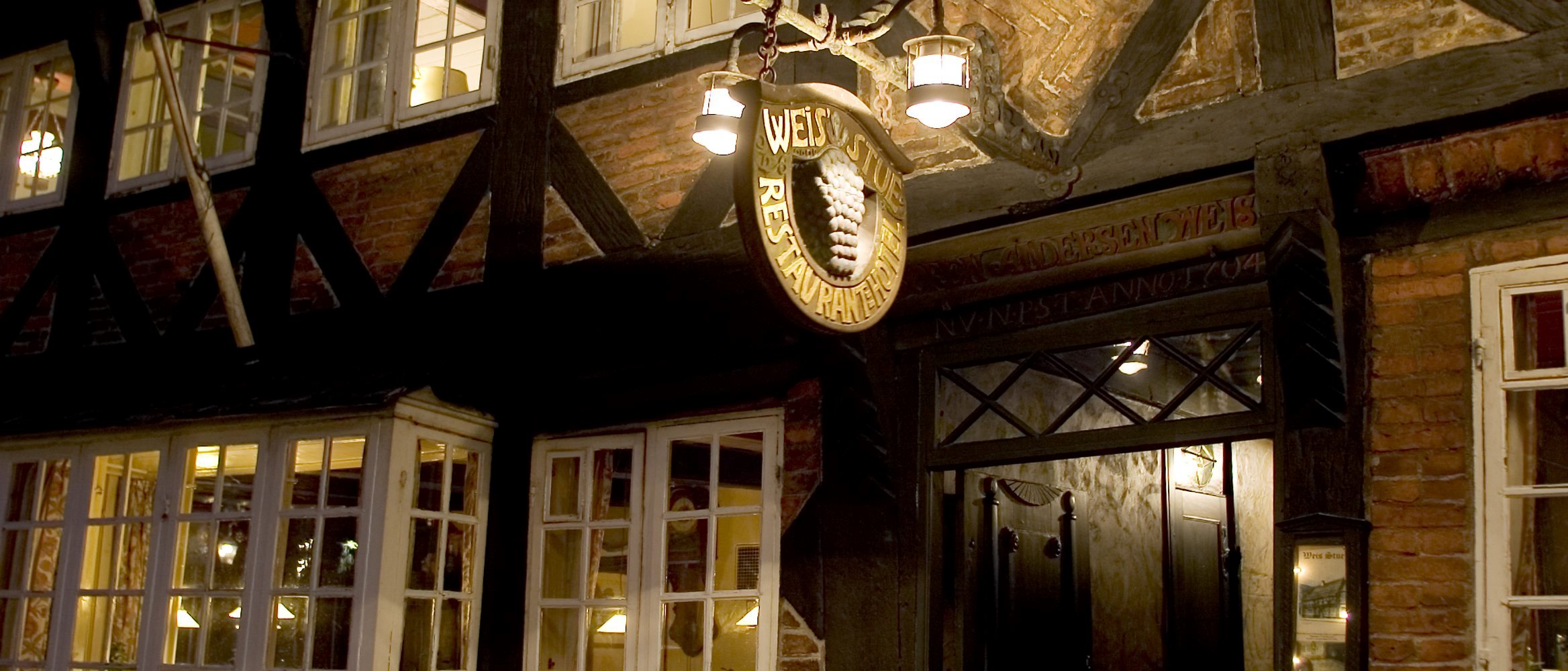

It is a half-timbered building, dating all the way back to 1600. The inn still has its original interior from 1704 with decorated ceilings, Delft tiled sections, panelled walls depicting biblical subjects, a clock that is more than 400 years old and the approximately 700-year-old christening bowl.
The Night Watchman walks his round, starting at Weis Stue, from May to October, and in Week 7 and over Easter.
Read more about the Night Watchman’s rounds here



One of the first mentions of Ribe comes in an account of Ansgar’s life by the Archbishop of Hamburg, Remberrus. In 865 he wrote that Ansgar persuaded King Eric of Jutland “in the town of Ribe to establish a church and to appoint a priest.” Prior to medieval settlement and habitation, Ribe was inhabited by Vikings.
During the Middle Ages Ribe evolved into a large and extremely important town. The core of the town grew around the Cathedral, which in its present form was built in the 12th century. At a very early stage Ribe was granted the privileges of a market town, and in 1288 Erik Menved gave the citizens freedom from customs duties throughout the realm. As a commercial centre on the western coast of Jutland, Ribe’s nearest commercial, metropolitan neighbours were Hamburg and Bremen to the south, and Bergen to the north. Ships from Ribe visited Friesland, the Netherlands, England, France and the Mediterranean countries. On the pier in Ribe you could find products from cultured countries: for example, wine, silk and processed luxury goods. From Ribe, horses and steers from a large catchment area were exported. In 1519 alone 11,000 cattle and steers were exported. Starting during the reign of King Canute the Great and throughout the Middle Ages, the town had an important mint.
Many orders of nuns and monks had their convents and monasteries in the town. There were Benedictine nuns and Johannite nuns. There were Grey Friars and Black Friars. Even today we can see the magnificent old Black Friars Monastery adjacent to St Catherine’s Church.
In short, Ribe has been a cultural and commercial centre for centuries.
In 1580 a large fire ravaged the city and many of the ancient medieval buildings vanished in the flames.
Weis Stue was built on the foundations of a medieval building. The building was constructed with two storeys with 8 half-timbered panels, though parts of the ground floor are brick built. The roof is tiled. The masonry and gable are red brick, though the three easternmost panels of the second floor are bricked with red and yellow Dutch bricks laid in a pattern. The house has a bay window with a lead roof. Facing the street the timberwork is tarred black, while it is painted red on the courtyard side. Here the gables are painted yellow. The building was constructed in two phases. The 5 westernmost sections were constructed around 1600, while the three easternmost sections were constructed about twenty years later. The wall of the cellar facing the street, which is 95-cm thick, is made of large red medieval bricks. There is a well in the cellar.

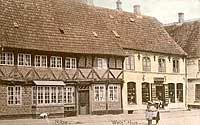
Weis Stue omkring år 1900
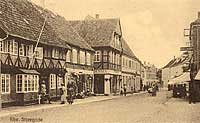
Weis Gård i Storegade i begyndelsen af det 1900-århundrede
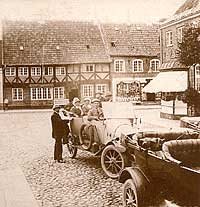
Weis Stue set fra Torvet. Ca. år 1915
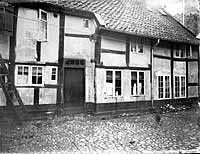
Gårdsiden af Weis Stue i Ribe, ca. 1940
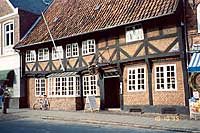
Weis Stue 1995
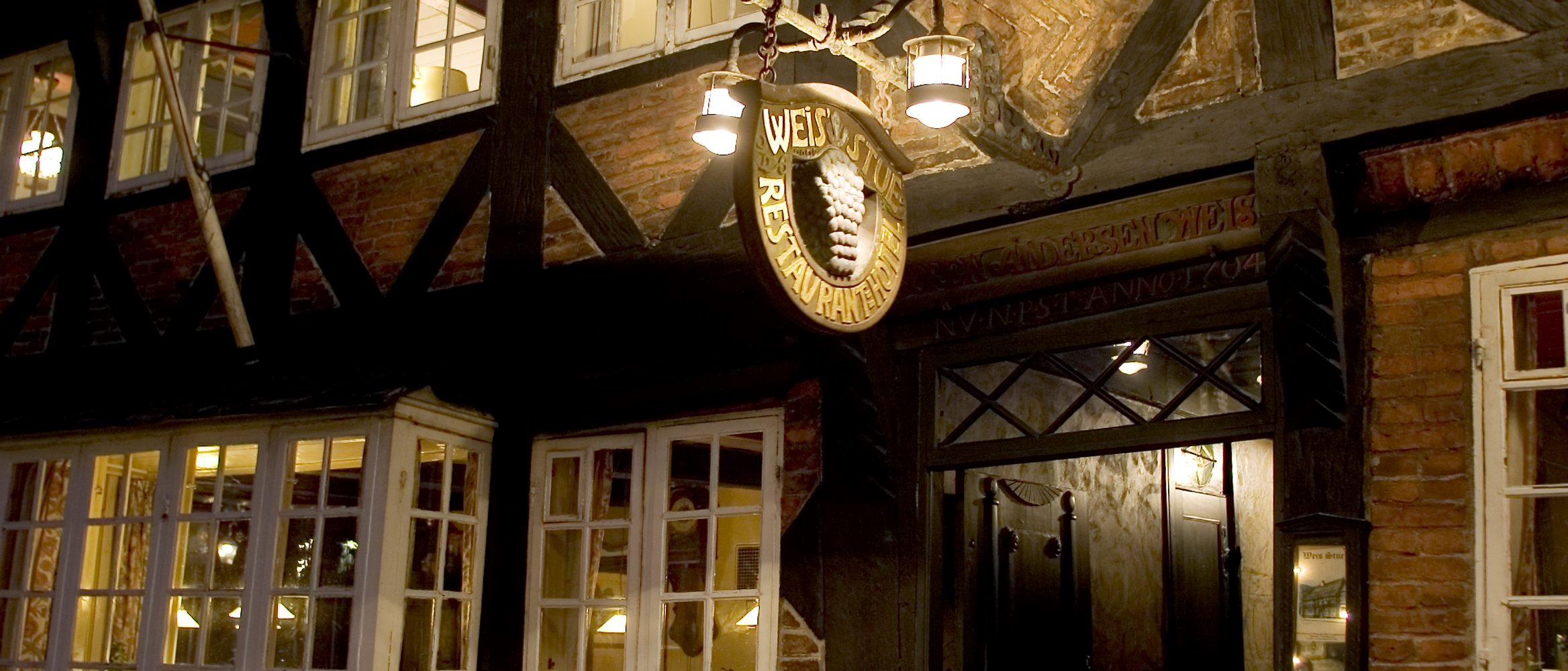
Weis Stue i nutiden

We do not know who owned the building in the first century of its existence. However, by 1704 the house was owned by the Thun family: possibly by the parents of the Rev. Peder Thun and the coppersmith, Lorentz Thun. The Rev. Peder Thun (1708-1783) was attached to the grammar school, while Lorentz was married to a certain Cecilie Marie. The latter took over the House, and it was Cecilie Thun, who with full power of attorney sold the house according to the deeds of 27 September 1762: “House, consisting of 8 sections along with carriage shed, workshop, scullery and barn and driveway through Raamand Ussings Gaard for a purchase price of 570 rigsdaler.” The buyer was Anders Andersen Weis. The Weis family had been living and working in Ribe for a number of years when they bought the Thuns’ house. The family had moved here from the south, but had settled in a property on Mellemdammen, where they traded in canvas.
Anders Andersen Weiss was born on 4 April 1719 in Ribe and died on 2 August 1795 in the same town. He was married to Karen Marie Johansdatter (b. 15 December 1729). She died on 3 May 1797 in Ribe. In the Cathedral a tombstone was erected for Weiss and his wife. Anders Weiss purchased homemade canvas from peasants and resold it. He had his storeroom in a room west of the Skænkestuen, which has now been joined to it. The couple had 7 children, including Søren Andersen Weiss, who was born on 6 May 1761 in Ribe and who died there on 16 December 1853. He was married to Kirstine Pedersdatter (22 March 1777 to 15 July 1832).
Søren took over the building from his mother by deed on 1 November 1796, paying 550 rigsdaler for it.
On 8 December 1796 Søren Weiss acquired a licence to trade as a canvas dealer. We do not know precisely how long they had been running a tavern business in the building, but at the time it was quite normal for people, who had come from the countryside to sell their canvas goods, to bring food with them and to buy beer and schnapps on the premises. In any case, on 18 December 1830, Søren Weiss was awarded a trading licence as “a schnapps distiller and tavern owner in accordance with the county’s authorisation,” regardless of the fact that he had not passed the “exam prescribed for schnapps distillers.” There is no doubt that alcohol had been served prior to this time. We learn that in 1810 Madam Weiss ruled the old tap room with a rod of iron. It is reported that she refused to serve alcohol to inebriated customers and that, when doing so, she could be somewhat heavy handed.
In 1805 Søren Weiss had to take legal action against his neighbour, the watchmaker Jens Schultz, about the driveway to his courtyard. A court ruling of 11 February 1806 granted Weiss the right to drive in and out of Schultz’s gate in Tingslippe.
Søren and Kirstine had four children. One of them, Anders Pedersen Weiss (11 October 1813-21 June 1872) was to continue managing the Weiss tavern. In 1848 he married Ane Kathrine Clemmensen (24 December 1818-5 March 1889).
Anders Weiss took over the tavern and the property on 27 July 1833, but under the aegis of his father. It was not until 4 January 1859 that he was granted a trading licence as a schnapps distiller and tavern owner. In 1864, Anders Pedersen Weiss, along with other dignitaries in the town, was taken to Rendsborg as a hostage. Eventually Anders Weiss became the owner of some fields and meadows in the vicinity of Ribe, chiefly by way of repayment of money that was owed him.
The last generation of the Weiss family was Anders and Ane Kathrine’s son, Søren Andersen Weiss (b. 8 August 1852). On 7 September 1883 he married Karen Jensen. He inherited the title deeds and took over the property in 1889. He continued to run the tavern business until autumn 1913, when he sold the property to Ribe Municipality for DKK 30,000. His family had managed the tavern business and the company in the same premises for four generations: a total of 152 years.
Prior to the sale to Ribe Municipality, he had been in negotiations with the Danish Consul in New Jersey, I.P. Holm to sell the house and have it moved across the Atlantic to a museum in the United States. Fortunately this plan came to nothing.
After the municipality took over the property, the architect Christen Borch and the National Museum of Denmark under the supervision of Christian Axel Jensen, MA, undertook a comprehensive restoration of the old buildings. This led to several interesting discoveries: for example, a piece of wood with initials and dated 1704.
After the restoration was completed, on 15 May 1914 the merchant’s house was leased to Nissen, Head Waiter at Klubbens Hotel. He became the first publican under municipal ownership. He ran the tavern until 1917, when the restaurateur M. Bertelsen and his wife, Johanne Marie moved in. Bertelsen was a master painter from Horsens, but decided to settle in Ribe, where he became a respected restaurateur. He died on 22 March 1937, but his wife, Johanne Marie Bertelsen continued to manage the tavern and went on to celebrate her 25th anniversary in Weiss Stue.
She was succeeded by Olga Henriksen, who managed the business until 23 May 1967, when the restaurateur Willy Jung took over Weiss Stue. Before restaurant operations resumed in autumn 1967, there was a thorough refurbishment of the building. For example, the old stoves were replaced by district heating. In 1973, the restaurateur couple, Jette and Knud Nielsen succeeded Willy Jung and managed Weiss Stue as the hotel restaurant as it is today. They purchased the building from Ribe Municipality, and today Weis Stue is once again privately owned.
Sources:
Hans Henrik Engquist: Bevaringsplan for Ribe. 1969
Press coverage